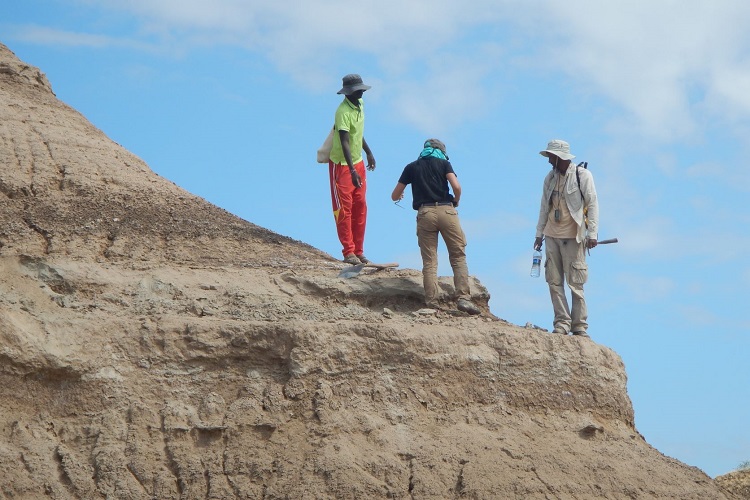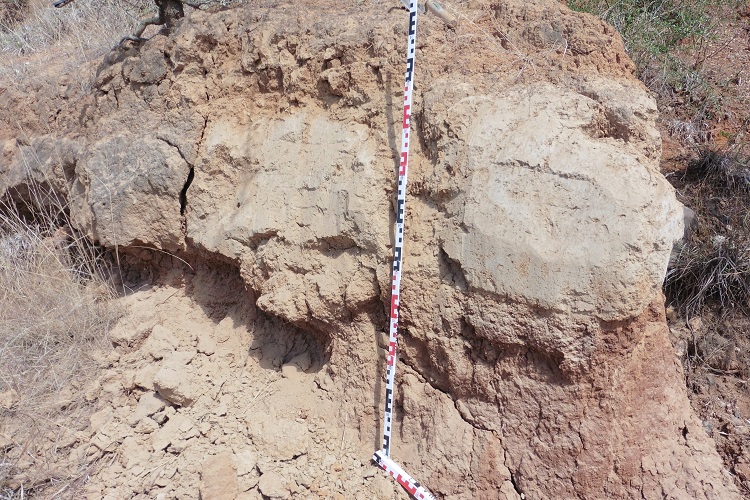Earliest human remains in eastern Africa dated to more than 230,000 years ago
The age of the oldest fossils in eastern Africa widely recognised as representing our species, Homo sapiens, has long been uncertain. Now, dating of a massive volcanic eruption in Ethiopia by scientists from the University of St Andrews reveals they are much older than previously thought.
The remains, known as Omo I, were found in Ethiopia in the late 1960s, and scientists have been attempting to date them precisely ever since. The team of international scientists, led by the University of Cambridge with researchers from the School of Earth and Environmental Sciences at St Andrews, has reassessed the age of the remains, revealing they are almost 30,000 years older than previously suggested.
Previous attempts to date the fossils suggested they were less than 200,000 years old, however, new research shows they must be older than a colossal volcanic eruption that took place 230,000 years ago. The results are reported in the journal Nature.
By using the chemical fingerprints of volcanic ash layers found above and below the sediments in which the fossils were found, the international team of scientists successfully reassessed the age of the Omo I remains – and Homo sapiens as a species.

The Omo I remains were found in the Omo Kibish Formation in southwestern Ethiopia, within the East African Rift valley. The region is an area of high volcanic activity, and a rich source of early human remains and artefacts, such as stone tools. By dating the layers of volcanic ash above and below, where archaeological and fossil materials are found, scientists identified Omo I as the earliest evidence of our species, Homo sapiens.
“Using these methods, the generally accepted age of the Omo fossils is under 200,000 years, but there’s been a lot of uncertainty around this date,” said Dr Céline Vidal from Cambridge’s Department of Geography, the paper’s lead author. “The fossils were found in a sequence, below a thick layer of volcanic ash that nobody had managed to date with radiometric techniques because the ash is too fine-grained.”
As part of a four-year project led by Professor Clive Oppenheimer, Dr Vidal and her colleagues, including Dr Will Hutchison from St Andrews’ School of Earth and Environmental Sciences, have been attempting to date all the major volcanic eruptions in the Ethiopian Rift around the time of the emergence of Homo sapiens, a period known as the late Middle Pleistocene.
The researchers collected pumice rock samples from the volcanic deposits and ground them down to sub-millimetre size.
“Each eruption has its own fingerprint – its own evolutionary story below the surface, which is determined by the pathway the magma followed,” said Dr Vidal. “Once you’ve crushed the rock, you free the minerals within, and then you can date them, and identify the chemical signature of the volcanic glass that holds the minerals together.”
The researchers carried out new geochemical analysis to link the fingerprint of the thick volcanic ash layer from the Kamoya Hominin Site (KHS) with an eruption of Shala volcano, more than 400km away. The team then dated pumice samples from the volcano to 230,000 years ago. Since the Omo I fossils were found deeper than this particular ash layer, they must be more than 230,000 years old.
“Although we have known that there were many colossal eruptions in East Africa during the evolution of our species, this is the first time we’ve been able to link the eruption source to the ash layers surrounding these unique Homo sapiens fossils” said Dr Will Hutchison from the School of Earth and Environmental Sciences.
“These ash layers provide unique regional time markers and clearly demonstrate that oldest Homo sapiens are much older than previously thought.”

The researchers say that while this study shows a new minimum age for Homo sapiens in eastern Africa, it’s possible that new finds and new studies may extend the age of our species even further back in time.
“We can only date humanity based on the fossils that we have, so it’s impossible to say that this is the definitive age of our species,” said Dr Vidal. “The study of human evolution is always in motion: boundaries and timelines change as our understanding improves. But these fossils show just how resilient humans are: that we survived, thrived and migrated in an area that was so prone to natural disasters.”
“It’s probably no coincidence that our earliest ancestors lived in such a geologically active rift valley – it collected rainfall in lakes, providing fresh water and attracting animals, and served as a natural migration corridor stretching thousands of kilometres,” added Professor Oppenheimer. “The volcanoes provided fantastic materials to make stone tools and from time to time we had to develop our cognitive skills when large eruptions transformed the landscape.”
“Our forensic approach provides a new minimum age for Homo sapiens in eastern Africa, but the challenge still remains to provide a cap, a maximum age, for their emergence, which is widely believed to have taken place in this region,” said co-author Professor Christine Lane, head of the Cambridge Tephra Laboratory, where much of the work was carried out. “It’s possible that new finds and new studies may extend the age of our species even further back in time.”
“There are many other ash layers we are trying to correlate with eruptions of the Ethiopian Rift and ash deposits from other sedimentary formations,” said Dr Vidal. “In time, we hope to better constrain the age of other fossils in the region.”
The research was supported in part by the Leverhulme Trust, the Cambridge-Africa ALBORADA Research Fund, the Natural Environment Research Council and the National Environmental Isotope Facility. Dr Céline Vidal is a Fellow of Fitzwilliam College, Cambridge.
The paper, ‘Age of the oldest Homo sapiens from eastern Africa’, by Céline M. Vidal et al is published in Nature (2022). Please include the paper's DOI: 10.1038/s41586-021-04275-8 in all references and credit Nature as the source.
Issued by the University of Cambridge and University of St Andrews Communications Offices.